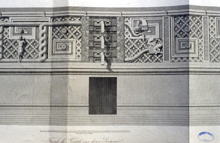 |
1838. Print, the earliest image of this famous section of the frieze, based on drawings made before portions of the frieze collapsed. In this print, Waldeck's shows how he thought this section originally looked, though without color.
Fold-out print mounted in Frédéric Waldeck, Voyage pittoresque et archéologique dan la province d’Yucatan, 1838. Reconstructed by Waldeck from his 1834 and 1836 drawings on-site. This image scanned from a 35mm slide taken from a copy in the University of Cincinnati Library, with appreciation. Because this print was deliberately not pressed flat, this image shows the paper creased and slightly bent.
1838
|
|
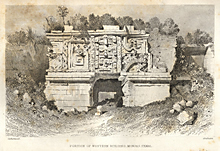 |
1843. Print, the earliest image after some sections of the frieze had collapsed, attempting to show how this portion looked when drawn in 1841-42. This section of the front facade is over the 2nd doorway from right.
Scanned from Stephens, Incidents of Travel
in Yucatan, 1843; closely based on Catherwood’s 1841-42 on-site drawing.
1843 |
|
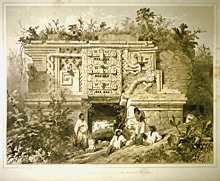 |
1844. Print, same section of frieze, also drawn by Catherwood. In this more glamorized chromolithograph, Catherwood has slightly straightened and reconstructed the structure. A few details are more accurate than in his print at left.
Chromolithograph in Frederick Catherwood, Views of Ancient
Monuments in Central America, Chiapas, and Yucatan, 1844. Based on Catherwood’s 1839-42
on-site drawing. This image scanned from a 35mm slide taken from the copy in the AMNH (RF-13-K). Reproduced Courtesy of The Library, Special Collections, Amerian Museum of Natural History. |
|
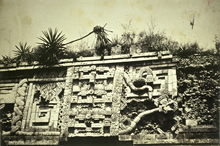 |
1859-60, 1862. Earliest photograph of this famous section of the frieze; showing the mask stack, serpents and other parts remarkably well preserved.
Photograph mounted in Vol.1 of Désiré Charnay, Cités et Ruines Américaines, 1862; taken by Charnay 1859-60. This image scanned from a 35mm slide taken from a copy in the AMNH (RF-106-D). Reproduced Courtesy of The Library, Special Collections, American Museum of Natural History. |
|
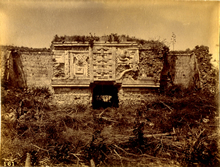 |
1888-1891. Photograph of same section of frieze, over 2nd doorway from right; showing almost no deterioration in previous c.30 years.
1888-1891 photograph by Henry N. Sweet as a member of the Thompson/Peabody expedition; scanned from 35mm slide of original photograph at Dumbarton Oaks. Reproduced Courtesy of the Peabody Museum of Archaeology and Ethnology, Harvard University. |
|
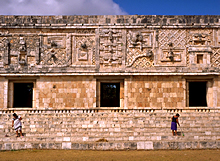 |
2002. Same section as in photos at left and above, portions reconstructed and restored. Portions that had survived intact helped to provide a basis for restoration of other sections.
Jan. 2002 |
|
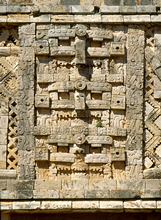 |
Detail of same mask stack, largely intact and complete except for broken snouts;
showing high quality fitting of mosaic stones.
Jan. 2001 |
|
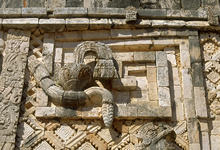 |
Detail of the rattle at the end
of the tail of the upper serpent; with tuft of feathers above (cf. page
3 for the opposite ends of the two snakes).
Jan. 2001 |
|
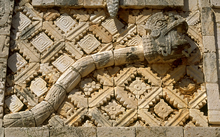 |
Section of serpent within this enclosing rectangle of frieze; also showing background of serrated
latticework and enclosed motifs, some of flowers.
Jan. 2001 |
|
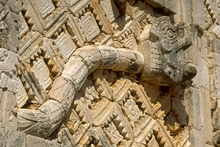 |
Angled detail showing junction of Serpent's feathered body
and head.
Jan. 2001 |
|
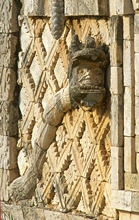 |
Human head, wearing mask,
within serpent's open jaws.
Jan. 2001 |
|
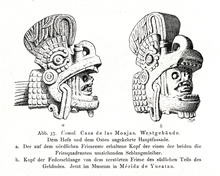 |
1917. "Fig. 37. Uxmal. House of the Nuns. West building. Main facade facing
the courtyard and the east. a. The remaining head on the northern frieze remnants of one of the two serpent bodies surrounding the frieze quadrant. b. Head of the feather serpent from the damaged frieze on the southern section of the building. Now in the Museum in Merida de Yucatan."
Scanned from Eduard Seler, “Die Ruinen von Uxmal,” 1917; closely based on Seler’s on-site drawing (fig.37a, b). |
|